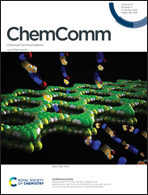Remarkable untangled dynamics behavior of multicyclic branched polystyrenes†
Abstract
A typical multicyclic branched-topology polystyrene (c-BPS) with high molecular weight (30 K ≤ Mw MALLS ≤ 300 K g mol−1) and narrow dispersity (1.2 ≤ Đ ≤ 1.3) was efficiently synthesized by combining atom transfer radical polymerization (ATRP) and atom transfer radical coupling (ATRC) techniques. The topological constraints imposed by the presence of cyclic units and branch points had a marked influence on the entanglement behaviors of the polymer chains in solution. Therefore, c-BPS possesses the lowest loss modulus (G′′) and viscosity (η), the highest diffusion coefficient (D0), the largest mesh size (ξ) and the fastest terminal relaxation (TR), compared with branched and linear precursors.



 Please wait while we load your content...
Please wait while we load your content...